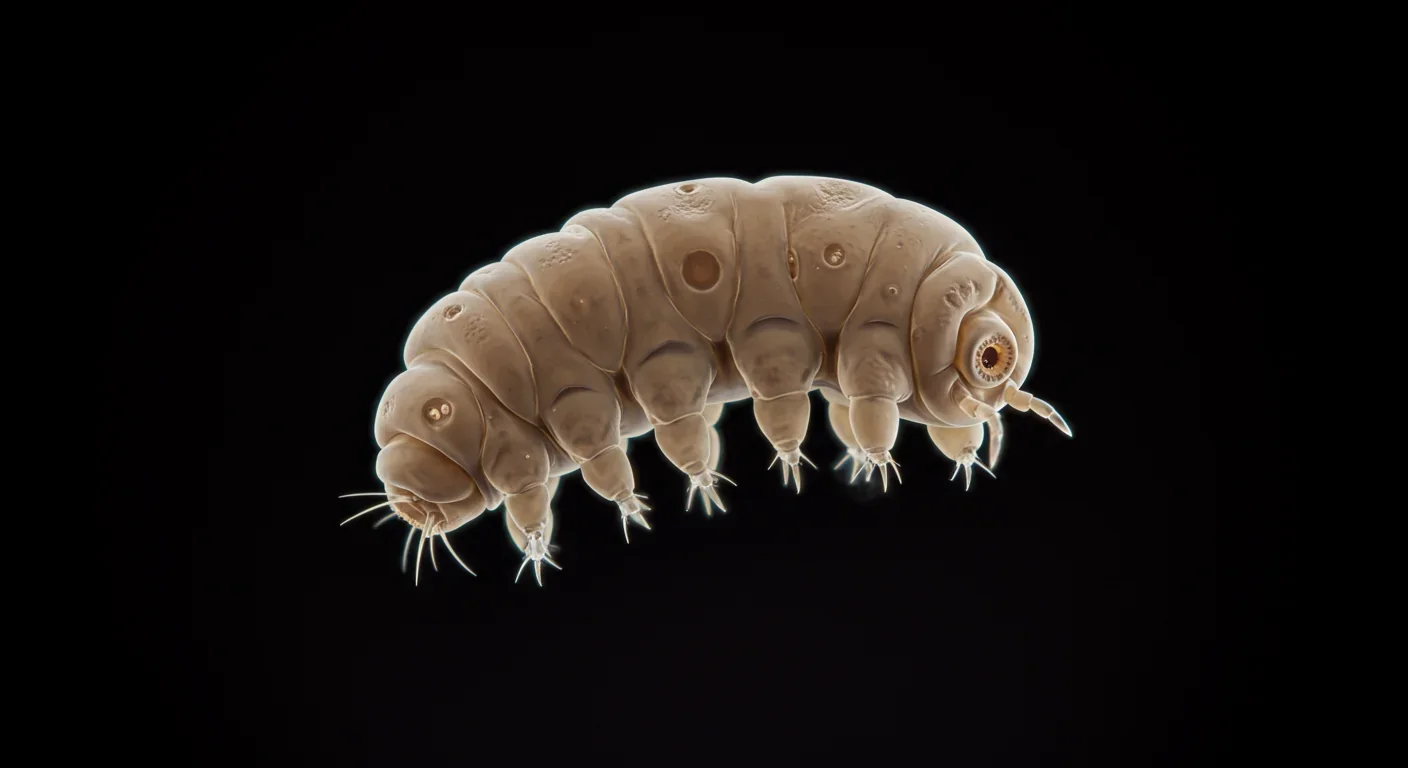Fusion Rockets Could Reach 10% Light Speed: The Breakthrough

TL;DR: Tardigrades survive space's vacuum and radiation by entering cryptobiosis, using protective proteins like Dsup to shield DNA. Their extreme resilience is inspiring biotechnology breakthroughs and reshaping our search for extraterrestrial life.

Right now, floating somewhere above Earth, frozen solid and exposed to lethal radiation that would turn you into ash, microscopic creatures are waiting. They're not breathing. Their cells have replaced most of their water with a special glass. And when scientists finally bring them back to Earth and add water, they'll simply wake up, stretch their eight stubby legs, and waddle away like nothing happened. These aren't aliens from science fiction. They're tardigrades, and they're rewriting everything we thought we knew about the limits of life.
Tardigrades measure less than a millimeter long, so tiny you'd need a microscope to see their stumpy legs and vacuum-cleaner mouths. But these "water bears" possess a superpower that makes them virtually indestructible. When conditions get tough, tardigrades enter cryptobiosis, a state between life and death where they shut down all metabolic activity. They curl into a barrel-shaped tun, expel 97% of their water, and replace it with trehalose, a sugar that forms a protective glass around their cells.
In this dormant state, tardigrades have survived being frozen at -272°C, just one degree above absolute zero. They've endured temperatures reaching 151°C. They've withstood pressures six times greater than those at the ocean's deepest trenches. And most remarkably, they've survived the vacuum of space with its brutal cocktail of radiation and zero pressure.
Scientists have documented over 1,300 tardigrade species living everywhere from mountaintops to ocean sediments. Some species can survive in your backyard moss. Others thrive in Antarctic ice. This ubiquity across extreme environments made researchers wonder: could these creatures survive beyond Earth entirely?
The answer came in 2007, when European scientists launched tardigrades aboard the FOTON-M3 satellite. For 10 days, these microscopic pioneers floated in low Earth orbit, completely exposed to the vacuum of space. Some faced only cosmic vacuum. Others endured the full spectrum of solar radiation, including ultraviolet rays that would shred DNA in seconds.
When the satellite returned, scientists rehydrated the tardigrades. Most of those exposed only to vacuum recovered completely, resuming normal activity and even reproducing successfully. The radiation-exposed group fared worse, but still, a remarkable percentage survived and produced viable offspring. This was the first proof that complex animals could survive direct space exposure.
The experiments continued. On the International Space Station, tardigrades spent 16 months outside the hull, experiencing temperature swings from -150°C to 121°C. Japanese researchers sent them into low Earth orbit repeatedly. Chinese scientists have launched them multiple times, studying exactly which genes activate during space exposure.
Each mission revealed more about their resilience. The tardigrades that survived best had activated specific protective proteins before entering cryptobiosis. Their DNA repair mechanisms worked overtime. Some species performed better than others, suggesting evolution had fine-tuned certain tardigrade lineages for extreme stress.

Recent discoveries have revealed how tardigrades achieve this impossible feat. The key lies in a protein called Dsup, short for "damage suppressor." Only the most radiation-resistant tardigrade species possess this protein, and Dsup binds to chromatin where it shields DNA from radiation-induced breaks.
When researchers expressed Dsup in human cells, those cells showed significantly increased radiation resistance. The same happened in yeast and other organisms. It's as if tardigrades evolved their own internal radiation suit, protecting genetic material from cosmic rays that would otherwise shatter the double helix into useless fragments.
But Dsup isn't working alone. Tardigrades produce extraordinary amounts of antioxidants that neutralize harmful free radicals created by radiation. They manufacture unique versions of proteins that remain stable when everything else denatures. Their cells contain special molecules that protect membranes from rupturing in vacuum conditions.
The trehalose glass formed during cryptobiosis acts like biological amber, preserving cellular structures in suspended animation. Unlike ice crystals that would puncture cell membranes, this sugar glass forms a stable matrix that holds everything in place. When water returns, the glass dissolves smoothly, and cellular machinery simply restarts.
These findings have profound implications for how we search for life beyond Earth. If microscopic animals can survive unprotected in space, what could endure inside a meteor? The theory of panspermia, which proposes that life spreads between planets on space rocks, suddenly seems less far-fetched.
Mars missions now consider tardigrade-like organisms as potential Martian life forms. If Earth microbes can enter cryptobiosis and survive radiation, perhaps Martian life evolved similar strategies. Future Mars samples might need to be tested for dormant organisms that could revive with simple addition of water.
Europa, Jupiter's ice-covered moon, has become another intriguing target. Beneath kilometers of ice lies a vast ocean, potentially harboring life. If organisms there evolved tardigrade-like dormancy, they could survive in ice pockets, waiting out periods when conditions deteriorate. The same logic applies to Enceladus, Saturn's geyser-spewing moon, where ice crystals ejected into space might contain frozen life.
Beyond detection, tardigrades inform planetary protection protocols. Space agencies worry about contaminating other worlds with Earth organisms. Knowing that tardigrades can survive space transit means sterilization procedures need to be more rigorous. A stowaway water bear entering cryptobiosis could potentially colonize Mars or Europa if it reaches suitable habitat.
The race is on to harness tardigrade superpowers for human benefit. Vaccine manufacturers face a critical challenge: many vaccines require continuous refrigeration, making distribution to remote areas nearly impossible. Researchers are developing tardigrade-inspired protective coatings that could stabilize vaccines at room temperature using trehalose-based formulations.
Blood banks have similar problems. Red blood cells survive only 42 days when refrigerated, limiting supply availability. Scientists are testing whether tardigrade proteins could extend blood storage times dramatically, potentially keeping donations viable for months instead of weeks. Early experiments show trehalose can preserve cellular structures during freezing and thawing.
The agricultural sector sees potential too. Drought-resistant crops could incorporate genes that trigger tardigrade-like responses during water stress. Instead of dying, plants might enter reversible dormancy, reviving when rain returns. This could revolutionize farming in arid regions where crops currently fail during dry spells.
Chinese researchers have even explored incorporating tardigrade DNA into human stem cells, though this raises significant ethical questions. The goal involves radiation protection for astronauts or people undergoing radiation therapy, but the long-term effects remain completely unknown.

Should we be splicing tardigrade genes into humans? The question divides bioethicists and scientists. Proponents argue that radiation protection could save lives, enabling longer space missions and improving cancer treatments. Imagine astronauts journeying to Mars with enhanced DNA repair, reducing cancer risks from cosmic radiation.
Critics counter that we don't understand the unintended consequences. Dsup affects chromatin structure, potentially altering gene expression in unpredictable ways. The protein might interfere with normal cellular processes. Evolution optimized tardigrades over millions of years; copying individual components into humans could backfire catastrophically.
There's also the question of access. If tardigrade-enhanced therapies work, who gets them? Will only wealthy nations afford radiation-resistant blood or space-grade human enhancements? The technology could deepen existing inequalities, creating biological divides between enhanced and unenhanced populations.
Environmental concerns matter too. Drought-resistant crops sound beneficial until you consider ecosystem impacts. Plants engineered to survive anything might become invasive superweeds, outcompeting native species. Releasing such organisms into the wild could create ecological disasters we can't reverse.
Looking ahead, tardigrade research is accelerating. The Wellcome Sanger Institute has sequenced multiple tardigrade genomes, revealing the genetic basis for extreme survival. Each new species analyzed adds pieces to the puzzle, showing which genes are essential and which are optional extras.
Private space companies are already planning tardigrade payloads for commercial missions. SpaceX, Blue Origin, and others have partnered with universities to conduct long-duration space exposure experiments. The goal involves testing whether tardigrades can survive on the Moon's surface or in Mars-like conditions, answering whether these creatures could serve as bio-indicators during planetary exploration.
Pharmaceutical companies are investing heavily in tardigrade-derived technologies. Several biotechs have licensed university patents for trehalose-based preservation methods. Clinical trials for room-temperature vaccine formulations could begin within three years. Blood preservation technologies might reach hospitals within five.
The next decade will likely see tardigrade proteins in consumer products. Cosmetics companies already market DNA repair enzymes from other extremophiles; tardigrade-sourced ingredients are inevitable. Some researchers predict tardigrade genes in crops by 2030, though regulatory approval remains uncertain.
Tardigrades have survived five mass extinctions. They've outlived the dinosaurs. When the sun eventually expands and boils Earth's oceans, tardigrades in deep-sea sediments might survive even that, waiting in cryptobiosis for conditions that will never return. They are, in a very real sense, Earth's ultimate survivors.
What makes their story compelling isn't just the biology, remarkable as it is. It's what they reveal about possibility. For most of history, humans assumed life was fragile, requiring narrow temperature ranges, constant water, and protection from radiation. Tardigrades prove otherwise. Life can be astonishingly resilient, adapting to extremes we can barely imagine.
This resilience offers hope as we face climate change and contemplate space colonization. If microscopic animals can survive vacuum, radiation, and temperature extremes through biological innovation, perhaps we can engineer solutions to our own survival challenges. The proteins that shield tardigrade DNA could protect our cells. The mechanisms that preserve their cellular structures during dehydration could stabilize our medicines.
But tardigrades also teach humility. They've been perfecting survival for over 500 million years. We're newcomers by comparison, and our technological prowess doesn't guarantee longevity. As we venture into space and modify our biology using tardigrade blueprints, we should remember that these creatures succeeded through millions of years of evolutionary refinement. Our shortcuts might work, but they won't be battle-tested like tardigrade solutions.
The water bears floating in orbit right now, frozen and dormant, represent both an endpoint and a beginning. They're the culmination of evolution's greatest survival experiment. And they're the starting point for humanity's next chapter, where we learn from life's toughest organism to build technologies that extend our own survival into realms we've only dreamed of reaching.
So the next time you look up at the stars, remember: some of Earth's smallest creatures have already been there, survived what space could throw at them, and came back to tell the tale. Their story is far from over. In fact, for humanity, it might be just beginning.

Recent breakthroughs in fusion technology—including 351,000-gauss magnetic fields, AI-driven plasma diagnostics, and net energy gain at the National Ignition Facility—are transforming fusion propulsion from science fiction to engineering frontier. Scientists now have a realistic pathway to accelerate spacecraft to 10% of light speed, enabling a 43-year journey to Alpha Centauri. While challenges remain in miniaturization, neutron management, and sustained operation, the physics barriers have ...

Epigenetic clocks measure DNA methylation patterns to calculate biological age, which predicts disease risk up to 30 years before symptoms appear. Landmark studies show that accelerated epigenetic aging forecasts cardiovascular disease, diabetes, and neurodegeneration with remarkable accuracy. Lifestyle interventions—Mediterranean diet, structured exercise, quality sleep, stress management—can measurably reverse biological aging, reducing epigenetic age by 1-2 years within months. Commercial ...

Data centers consumed 415 terawatt-hours of electricity in 2024 and will nearly double that by 2030, driven by AI's insatiable energy appetite. Despite tech giants' renewable pledges, actual emissions are up to 662% higher than reported due to accounting loopholes. A digital pollution tax—similar to Europe's carbon border tariff—could finally force the industry to invest in efficiency technologies like liquid cooling, waste heat recovery, and time-matched renewable power, transforming volunta...

Humans are hardwired to see invisible agents—gods, ghosts, conspiracies—thanks to the Hyperactive Agency Detection Device (HADD), an evolutionary survival mechanism that favored false alarms over fatal misses. This cognitive bias, rooted in brain regions like the temporoparietal junction and medial prefrontal cortex, generates religious beliefs, animistic worldviews, and conspiracy theories across all cultures. Understanding HADD doesn't eliminate belief, but it helps us recognize when our pa...

The bombardier beetle has perfected a chemical defense system that human engineers are still trying to replicate: a two-chamber micro-combustion engine that mixes hydroquinone and hydrogen peroxide to create explosive 100°C sprays at up to 500 pulses per second, aimed with 270-degree precision. This tiny insect's biochemical marvel is inspiring revolutionary technologies in aerospace propulsion, pharmaceutical delivery, and fire suppression. By 2030, beetle-inspired systems could position sat...

The U.S. faces a catastrophic care worker shortage driven by poverty-level wages, overwhelming burnout, and systemic undervaluation. With 99% of nursing homes hiring and 9.7 million openings projected by 2034, the crisis threatens patient safety, family stability, and economic productivity. Evidence-based solutions—wage reforms, streamlined training, technology integration, and policy enforcement—exist and work, but require sustained political will and cultural recognition that caregiving is ...

Every major AI model was trained on copyrighted text scraped without permission, triggering billion-dollar lawsuits and forcing a reckoning between innovation and creator rights. The future depends on finding balance between transformative AI development and fair compensation for the people whose work fuels it.